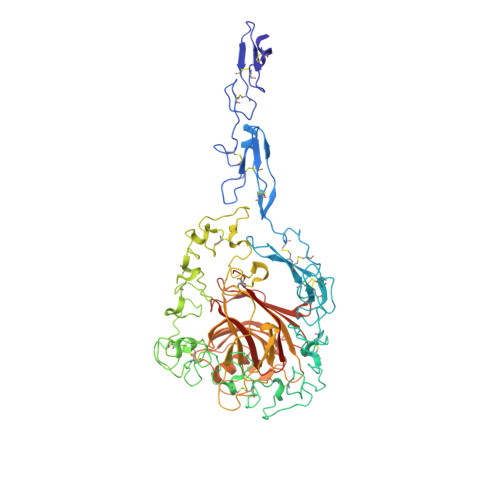Influences of the N700S Thrombospondin-1 Polymorphism on Protein Structure and Stability.
Carlson, C.B., Liu, Y., Keck, J.L., Mosher, D.F.(2008) J Biological Chem 283: 20069-20076
- PubMed: 18499674
- DOI: https://doi.org/10.1074/jbc.M800223200
- Primary Citation of Related Structures:
2RHP - PubMed Abstract:
Thrombospondins (THBSs) are multimodular, secreted proteins characterized by a signature domain comprising a unique set of 13 calcium-binding repeats flanked by epidermal growth factor (EGF)-like and lectin-like modules. A polymorphism that changes a conserved Asn to Ser at residue 700 in the most N-terminal calcium-binding repeat of THBS-1 (repeat 1C) is found in 8-10% of European populations and has been linked to increased risk of premature coronary artery disease. The Ser substitution leads to altered stability in the EGF-like and wire modules of the THBS-1 signature domain as assessed by differential scanning calorimetry carried out in 2 mm or 200 mum calcium. Studies of the melting profiles of the THBS-2 signature domain proteins with Asn or Ser at position 702 (homologous to 700 in THBS-1) revealed that the impact of the Ser allele is similar in both THBS-1 and THBS-2. Structure determination of the Ser(702) THBS-2 variant in 2 mm calcium showed that repeat 1C contains two bound calcium ions as in the crystal of the Asn(702) protein, including the ion that is coordinated by Asn(702), and is associated with changes in conformation of repeat 1C and the adjacent EGF-like modules. The Ser substitution leads to the decreased ability of soluble THBS-2 signature domain protein to bind 4B6.13, a conformation-sensitive monoclonal antibody that recognizes an epitope in repeat 1C. These results indicate that although THBS harboring the Ser allele binds a full complement of calcium ions, repeat 1C is altered, leading to destabilization of surrounding structures.
- Department of Medicine and Biomolecular Chemistry, University of Wisconsin, Madison, WI 53706, USA.
Organizational Affiliation:



















